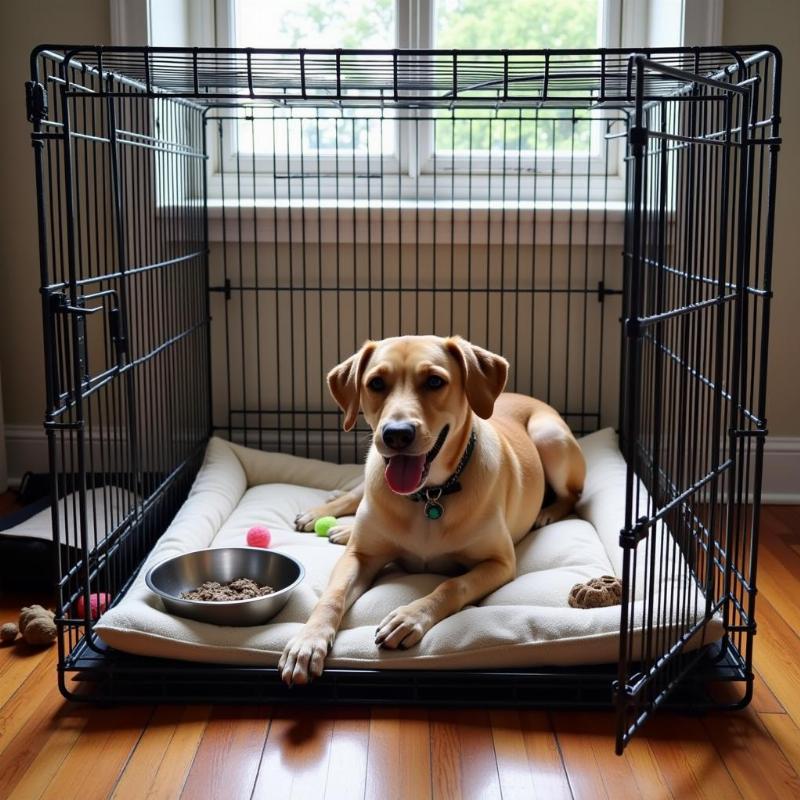Leaving your dog in a crate while you’re at work is a common practice, but it’s essential to do it right. This guide will cover everything you need to know about crating your dog while you’re away, ensuring their safety, comfort, and well-being, while also addressing potential behavioral issues. We’ll explore crate training techniques, ideal crate sizes, and how to make your dog’s crate a positive and secure space.
Is Crating Your Dog While at Work Cruel?
Many new dog owners grapple with this question. The answer isn’t a simple yes or no. Crating can be a valuable tool when done correctly, providing a safe haven for your dog and preventing destructive behaviors. However, leaving a dog in a crate for excessively long periods can be detrimental to their physical and mental health. Think of a crate as a den, not a jail. It should be a comfortable and secure space where your dog feels safe, not a place of punishment.
 Dog in crate while at work
Dog in crate while at work
How Long Can You Leave a Dog in a Crate While at Work?
The general rule of thumb is that adult dogs shouldn’t be crated for more than 6-8 hours at a stretch. Puppies require more frequent breaks due to their smaller bladder capacity. A good rule of thumb for puppies is to divide their age in months by two to get the maximum number of hours they can be crated. For example, a four-month-old puppy should be crated for no more than two hours at a time. Forcing your dog to hold their bladder for extended periods can lead to urinary tract infections and other health problems.
Choosing the Right Crate
Selecting the right crate is crucial. It should be large enough for your dog to stand up, turn around, and lie down comfortably. A crate that’s too small can be restrictive and stressful, while one that’s too large can defeat the purpose of providing a den-like feeling. Measure your dog carefully and consult crate size guides to ensure a proper fit.
Making the Crate a Positive Space
Introduce the crate gradually and positively. Start by placing treats and toys inside to encourage your dog to explore it on their own. Feed your dog meals in the crate and gradually increase the amount of time they spend inside with the door closed. Never force your dog into the crate or use it as punishment.
Dealing with Separation Anxiety
Some dogs experience separation anxiety when left alone, which can manifest as excessive barking, whining, or destructive behavior. If your dog exhibits these signs, consult with a veterinarian or a certified professional dog trainer. They can help you develop a behavior modification plan that may include crate training combined with other strategies like desensitization and counter-conditioning. how to crate train a rescue dog with separation anxiety can offer more guidance on this specific topic. If your dog’s barking becomes a problem while you are away, consider checking out my dog barks all day while i am at work.
Conclusion
Crating your dog while at work can be a safe and effective management tool, but it’s crucial to prioritize their well-being. By following these guidelines and ensuring your dog’s crate is a comfortable and positive space, you can make the experience less stressful for both of you. Remember, a well-adjusted dog is a happy dog. For alternative options, see our article on leaving dog out of crate while at work. You might also find helpful tips on keeping your furry friend entertained in our article how to keep a dog entertained while at work.
Beautdogs.us is your premier online destination for comprehensive and reliable information on dog care, breed specifics, and the best products for your furry friend. Whether you’re a new dog owner or a seasoned expert, we provide valuable resources to ensure a happy and healthy life for your canine companion. Explore our site for expert advice on everything from nutrition and training to grooming and health. Contact us at [email protected] or +1 501-555-7529 for personalized guidance. Beautdogs.us is here to help you navigate the world of dog ownership with confidence.